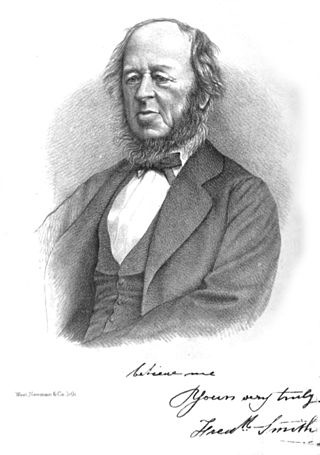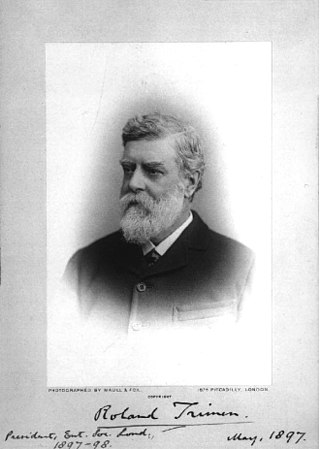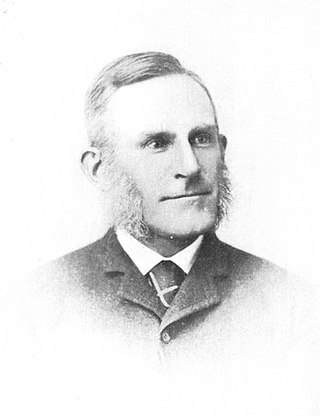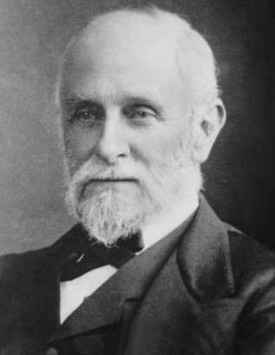Related Research Articles

Dru Drury was a British collector of natural history specimens and an entomologist. He had specimens collected from across the world through a network of ship's officers and collectors including Henry Smeathman. His collections were utilized by many entomologists of his time to describe and name new species and is best known for his book Illustrations of natural history which includes the names and descriptions of many insects, published in parts from 1770 to 1782 with copperplate engravings by Moses Harris.

James Francis Stephens was an English entomologist and naturalist. He is known for his 12 volume Illustrations of British Entomology (1846) and the Manual of British Beetles (1839).

Frederick Smith was a British entomologist who worked at the zoology department of the British Museum from 1849, specialising in the Hymenoptera.
Benjamin Dann Walsh was an English-born American entomologist who served as the first official state entomologist in Illinois. He was a leading influence during a time of significant transition in American entomology. Walsh championed the application of scientific methods to control agricultural pests. He was a proponent of biological control as an effective means to manage insects. He was also one of the first American scientists to support Charles Darwin's theory of evolution and was instrumental in securing its broad acceptance in the entomological community.

Roland Trimen FRS was a British-South African naturalist, best known for South African Butterflies (1887–89), a collaborative work with Colonel James Henry Bowker. He was among the first entomologists to investigate mimicry and polymorphism in butterflies and their restriction to females. He also collaborated with Charles Darwin to study the pollination of Disa orchids.

Alpheus Spring Packard Jr. LL.D. was an American entomologist and palaeontologist. He described over 500 new animal species – especially butterflies and moths – and was one of the founders of The American Naturalist.

Augustus Radcliffe Grote was a British entomologist who described over 1,000 species of butterflies and moths. He is best known for his work on North American Noctuidae. A number of species were named after him, including the moth Horama grotei.

James Charles Dale was an English naturalist who devoted almost all of his adult life to entomology.

Samuel Hubbard Scudder was an American entomologist and paleontologist. He was a leading figure in entomology during his lifetime and the founder of insect paleontology in America. In addition to fossil insects, he was an authority on butterflies (Lepidoptera) and grasshoppers (Orthoptera).
Charles Lionel Augustus de Nicéville was a curator at the Indian Museum in Calcutta. He studied the butterflies of the Indian Subcontinent and wrote a three volume monograph on the butterflies of India, Bangladesh, Nepal, Burma and Sri Lanka. He also studied the mantids of the Oriental region.
Alfred Edwin Eaton was an English clergyman and entomologist. He served as the vicar of Shepton Montague in Somerset. His main interests among insects were the Diptera and Ephemeroptera.

David Sharp was an English physician and entomologist who worked mainly on Coleoptera. He was among the most prolific publishers in the history of entomology with more than 250 papers that included seven major revisions and reviews and a highly influential work on the structure and modifications of the male genital structures among the beetle families. He was the editor of the Zoological Record for three decades.

James John Joicey FES was an English amateur entomologist, who assembled an extensive collection of Lepidoptera in his private research museum, called the Hill Museum, in Witley, Surrey. His collection, 40 years in the making, was considered to have been the second largest in the world held privately and to have numbered over 1.5 million specimens. Joicey was a fellow of the Zoological Society of London, the Royal Geographical Society, the Royal Entomological Society, the Royal Horticultural Society, and the Linnean Society of London.

John Jenner Weir, FLS, FZS was an English amateur entomologist, ornithologist and British civil servant. He is best known today for being one of the naturalists who corresponded with and provided important data to both Charles Darwin and Alfred Russel Wallace.

Charissa obscurata, the annulet or Scotch annulet, is a moth of the family Geometridae. The species was first described by Michael Denis and Ignaz Schiffermüller in 1775. It is found in most of Europe including the European part of Russia and in Asia Minor, the Caucasus, Armenia and Azerbaijan. In the mountains it rises up to 1800 meters. The habitat is rocky dry grasslands, boulder corridors, quarries as well as rocky steppe heaths and wine-growing areas.

Harrison Gray Dyar Jr. was an American entomologist. Dyar's Law, a pattern of geometric progression in the growth of insect parts, is named after him. He was also noted for eccentric pursuits which included digging tunnels under his home. He had a complicated personal life and along with his second wife he adopted the Baháʼí Faith.
Louis Beethoven Prout (1864–1943) was an English entomologist and musicologist.

Percy Ireland Lathy was an English entomologist who specialised in butterflies. He was an acquaintance of James John Joicey and was associated with Joicey's Hill Museum in Witley, Surrey.

Thomas Alexander Barns FZS FES, known in his private life as Alexander Barns, was an English businessman, explorer, big game hunter, author, artist, naturalist and lecturer connected with the opening up of Central Africa by Europeans in the early 20th century.

Reverend Joseph Greene was a British entomologist and lepidopterist best known for introducing the technique of digging up pupae for rearing. He published a book The Insect Hunter's Companion to popularize insect study.
References
- ↑ Frohawk, F. W. "untitled". The Entomologist. 54 (703): 303–304. Retrieved 3 May 2020.
- ↑ Farn, A. B. (18 November 1878). "Farn, A.B. to Darwin C.R. , Darwin Correspondence Project Letter 11747". The Darwin Papers. Manuscripts Room, Cambridge University Library, West Road, Cambridge, England. DAR 164:26.
- ↑ Hart, Adam G.; Stafford, Richard; Smith, Angela L.; Goodenough, Anne E. (9 February 2010). "Evidence for contemporary evolution during Darwin's lifetime". Current Biology. 20 (3): R95. doi: 10.1016/j.cub.2009.12.010 . ISSN 0960-9822. PMID 20144776. S2CID 31093691.
- ↑ Salmon, Michael A. (2000). The Aurelian Legacy: British Butterflies and Their Collectors. University of California Press. pp. 175–176.
- ↑ Kershaw, S. H. (1956). "Some recollections of Albert Brydges Farn". The Entomologist's Record and Journal of Variation . 68: 150–155 – via Internet archive.
- ↑ Jenkinson, Francis (1922). "Obituary. Albert Brydges Farn". The Entomologist's Monthly Magazine. 58: 20–22 – via Smithsonian Institution Libraries.
- ↑ The Insect Hunter's Companion. London: W. Swann, Sonnenschein & Allen. 1880.
- ↑ "List of Fellows of the Entomological Society of London". Transactions of the Entomological Society of London: xiii. 1902 – via Internet archive.
- ↑ "The Farn Collection of British Lepidoptera". The Entomologist. 55: 91. April 1922.